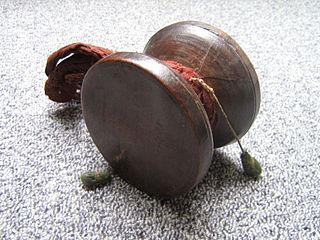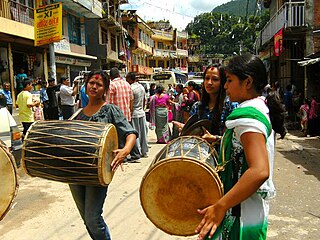Related Research Articles

A percussion instrument is a musical instrument that is sounded by being struck or scraped by a beater including attached or enclosed beaters or rattles struck, scraped or rubbed by hand or struck against another similar instrument. Excluding zoomusicological instruments and the human voice, the percussion family is believed to include the oldest musical instruments. In spite of being a very common term to designate instruments, and to relate them to their players, the percussionists, percussion is not a systematic classificatory category of instruments, as described by the scientific field of organology. It is shown below that percussion instruments may belong to the organological classes of idiophone, membranophone, aerophone and cordophone.
A membranophone is any musical instrument which produces sound primarily by way of a vibrating stretched membrane. It is one of the four main divisions of instruments in the original Hornbostel-Sachs scheme of musical instrument classification.

The goblet drum is a single-head membranophone with a goblet-shaped body. It is most commonly used in the traditional music of Egypt, where it is considered the national symbol of Egyptian Shaabi Music. The instrument is also featured in traditional music from West Asia, North Africa, South Asia, and Eastern Europe. The African djembe is also a goblet membranophone. This article focuses on the Middle Eastern and North African goblet drum.

The lion's roar is a membranophone instrument that has a drum head and a cord or horsehair passing through it. It gets its name from the sound it produces, which closely resembles a lion's roar. The home-made lion's roar is a drum that sits on the floor. The cord then makes friction with the drum head as it is moved back and forth.
A tenor drum is a membranophone without a snare. There are several types of tenor drums.

The fish drum is a Chinese percussion instrument. The name actually designates two rather different instruments, a membranophone and an idiophone.
Latin percussion is a family of percussion, membranophone, lamellophone and idiophone instruments used in Latin music.

A damaru is a small two-headed drum, used in Hinduism and Tibetan Buddhism. In Hinduism, the damaru is known as the instrument of the deity Shiva, associated with Tantric traditions. It is said to be created by Shiva to produce spiritual sounds by which the whole universe has been created and regulated. In Tibetan Buddhism, the damaru is used as an instrument in meditation practices.

Dhimay, Dhimaya or Dhime is a traditional Nepalese drum of the Newar people. According to the Hornbostel–Sachs classification, it belongs to the category of double-headed cylindrical membranophone.
Conical drums are a class of membranophone, or drum, that is characterized by sloping sides. They are usually one-headed. An example is the timbal. The conical drum also has strings on the side to keep the object together.

Barrel drums are a class of membranophone, or drum, characterized by a barrel-shape with a bulge in the middle. They are often one-headed and open at the bottom. Examples include the Vietnamese trong chau and the bendre of the Mossi of Burkina Faso. Barrel drum is played horizontally.

Hourglass drums are a sub-category of membranophone, or drum, characterized by an hourglass shape. They are also known as waisted drums. Drumheads are attached by laces, which may be squeezed during a performance to alter the pitch. The category also includes pellet drums such as the damaru, although not all pellet drums are hourglass shaped.
The Dhaa is a two-headed drum, "slightly smaller than the Dhimay." It belong to the membranophone group of Newar traditional musical instruments. It is a kind of drum specially played during the month of Gunlaa, the ninth month of Newar calendar. Dhaa is also known as "Gunlaa Baajan".
Directly struck membranophones is one of the sub-categories of musical instruments found in the Hornbostel-Sachs system of musical instrument classification. The type of membranophones or drums found in this group are those instruments that produce sound when struck directly by the performer. The membrane of these drums is hit with a stick, the hand, or something else. Drums that produce sound by means of plucking an attached string or by means of friction are grouped in a different category.

A pitched percussion instrument is a percussion instrument used to produce musical notes of one or more pitches, as opposed to an unpitched percussion instrument which is used to produce sounds of indefinite pitch.

There are several overlapping schemes for the classification of percussion instruments.
The sambal is a folk membranophone instrument from Western India. It consists of two wooden drums united from a side, with skin heads stretched on their top mouths. One drum is higher in pitch than the other one. This instrument is played with two wooden sticks, one beater having a circular tip. The sambal is also a traditional drum of the Gondhali people. The sambal is a folk drum found among the Kokna people of Dadra, Nagar Haveli, Maharashtra, Goa and North Karnataka in Western India.
References
- "534m Membranophones". SIL. Archived from the original on July 10, 2006. Retrieved January 4, 2007.